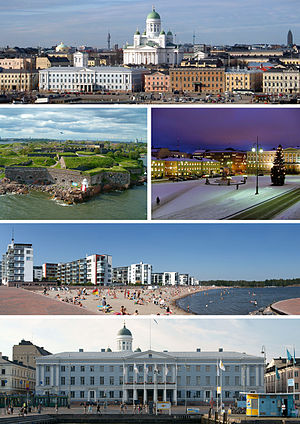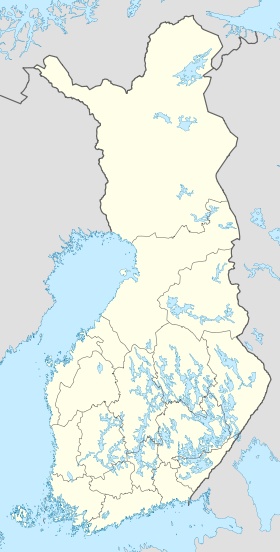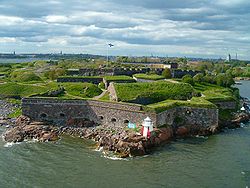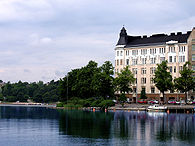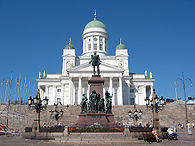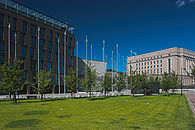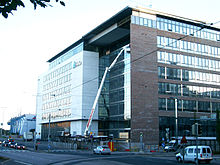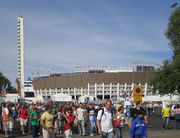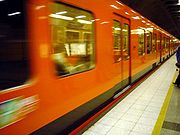- Helsinki
-
Helsinki
Helsinki – Helsingfors— City — Helsingin kaupunki
Helsingfors stadFrom top-left: Helsinki Cathedral, Suomenlinna, Senate Square, Aurinkolahti beach, City Hall 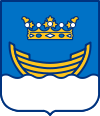
Coat of armsNickname(s): Stadi, Hesa[1] Location of Helsinki in Finland Coordinates: 60°10′15″N 024°56′15″E / 60.17083°N 24.9375°ECoordinates: 60°10′15″N 024°56′15″E / 60.17083°N 24.9375°E Country Finland Region Uusimaa Sub-region Helsinki Charter 1550 Capital city 1812 Government - Mayor Jussi Pajunen Area(2011-01-01)[2] - City 715.49 km2 (276.3 sq mi) - Land 213.75 km2 (82.5 sq mi) - Water 501.74 km2 (193.7 sq mi) - Urban 770.26 km2 (297.4 sq mi) - Metro 2,970.18 km2 (1,146.8 sq mi) Area rank 170th largest in Finland Population (2011-01-31)[3] - City 588,941 - Rank Largest in Finland - Density 2,755.28/km2 (7,136.1/sq mi) - Urban 1,046,355 - Urban density 1,358.44/km2 (3,518.3/sq mi) - Metro 1,325,775 - Metro density 446.36/km2 (1,156.1/sq mi) Population by native language[4] - Finnish 84.3% (official) - Swedish 6.1% (official) - Others 9.6% Population by age[5] - 0 to 14 13.7% - 15 to 64 72% - 65 or older 14.3% Time zone EET (UTC+2) - Summer (DST) EEST (UTC+3) Municipal tax rate[6] 18.5% Website www.hel.fi Helsinki (
 listen (help·info); Swedish: Helsingfors,
listen (help·info); Swedish: Helsingfors,  listen (help·info)) is the capital and largest city in Finland. It is in the region of Uusimaa, located in southern Finland, on the shore of the Gulf of Finland, an arm of the Baltic Sea. The population of the city of Helsinki is 588,941 (31 January 2011),[3] making it by far the most populous municipality in Finland. Helsinki is located some 400 kilometres (250 mi) east of Stockholm, Sweden, 300 kilometres (190 mi) west of St. Petersburg, Russia and 80 kilometres (50 mi) north of Tallinn, Estonia. Helsinki has close historical connections with these three cities.
listen (help·info)) is the capital and largest city in Finland. It is in the region of Uusimaa, located in southern Finland, on the shore of the Gulf of Finland, an arm of the Baltic Sea. The population of the city of Helsinki is 588,941 (31 January 2011),[3] making it by far the most populous municipality in Finland. Helsinki is located some 400 kilometres (250 mi) east of Stockholm, Sweden, 300 kilometres (190 mi) west of St. Petersburg, Russia and 80 kilometres (50 mi) north of Tallinn, Estonia. Helsinki has close historical connections with these three cities.The Helsinki Metropolitan Area includes the city of Helsinki and three other cities: Espoo and Vantaa, which immediately border Helsinki to the west and north, respectively; and Kauniainen, which is an enclave within the city of Espoo. The Helsinki metropolitan area is the world's northernmost urban area among those with a population of over one million people, and the city is the northernmost capital of a EU member state. Altogether 1.1 million people, approximately one in five Finns, live in the Helsinki Metropolitan Area.
Helsinki is Finland's major political, educational, financial, cultural and research centre as well as one of northern Europe's major cities. Approximately 70% of foreign companies operating in Finland have settled in the Helsinki region.[7]
The nearby city of Vantaa in the Helsinki metropolitan area is the location of Helsinki-Vantaa Airport, with frequent service to various destinations in Europe and Asia. Since early 2009, Helsinki has been exploring a merger with Vantaa. On 30 March 2009, the city council of Vantaa agreed to review Helsinki's proposal of a possible merger, while emphasizing that the review is not about the possibility of terminating the existence of the city of Vantaa.[8] On 31 January 2011, the city council of Vantaa turned down Helsinki's proposal of a possible merger, with 45 votes against the proposal compared to 22 in favour of it.[9]
In 2009, Helsinki was chosen to be the World Design Capital for 2012[10] by the International Council of Societies of Industrial Design, narrowly beating Eindhoven for the title.
Contents
History
Early history
Helsinki was established as a trading town by King Gustav I of Sweden in 1550 as the town of Helsingfors, which he intended to be a rival to the Hanseatic city of Reval (today known as Tallinn). Little came of the plans as Helsinki remained a tiny town plagued by poverty, wars, and diseases. The plague of 1710 killed the greater part of the inhabitants of Helsinki.[11] The construction of the naval fortress Sveaborg (In Finnish Viapori, today also Suomenlinna) in the 18th century helped improve Helsinki's status, but it was not until Russia defeated Sweden in the Finnish War and annexed Finland as the autonomous Grand Duchy of Finland in 1809 that the town began to develop into a substantial city.
Czar Alexander I of Russia moved the Finnish capital from Turku to Helsinki to reduce Swedish influence in Finland. The Royal Academy of Turku, back then the country's only university, was relocated to Helsinki in 1827 and eventually became the modern University of Helsinki. The move consolidated the city's new role and helped set it on the path of continuous growth. This transformation is highly apparent in the downtown core, which was rebuilt in neoclassical style to resemble St. Petersburg. As elsewhere, technological advancements such as railroads and industrialization were key factors behind the city's growth.
Twentieth century
Despite the tumultuousness of Finnish history during the first half of the 20th century, Helsinki continued its steady development. A landmark event was the XV Olympiad (1952 Olympic Games) held in Helsinki. Finland's rapid urbanization in the 1970s, occurring late relative to the rest of Europe, tripled the population in the metropolitan area, and the Helsinki Metro subway system was built. The relatively sparse population density of Helsinki and its peculiar structure have often been attributed to the lateness of its growth.[citation needed]
Name
The Swedish name Helsingfors ([hɛlsiŋˈfɔrs] or [hɛlsiŋˈfɔʂ]) is the original official name of the city of Helsinki (in the very beginning, spelled Hellssingeforss). The Finnish language form of the name probably originates from Helsinga and similar names used for the river that is currently known as the Vantaa River as documented already in the 14th century. Helsinki (pronounced with the stress on the first syllable: Finnish pronunciation: [ˈhelsiŋki]), is used to refer to the city in all languages except Swedish, Norwegian and Danish. Helsingfors comes from the name of the surrounding parish, Helsinge (source for Finnish Helsinki) and the rapids (Swedish: fors), which flowed through the original village. The name Helsinge may have originated with medieval Swedish settlers who came from Hälsingland in Sweden. Others have proposed that the name derives from the Swedish word hals (neck), referring to the narrowest part of the river, i.e. the rapids.[12]
In Helsinki slang the city is nicknamed as either Stadi (from the Swedish word stad, meaning "city") or Hesa (short of Helsinki + slang suffix sa), with Stadi being used to assert that the speaker is native to the city.[1] Helsset is the Northern Saami name of Helsinki.
Geography
Helsinki is spread across a number of bays and peninsulas and over a number of islands. The inner city area occupies a southern peninsula, which is rarely referred to by its actual name Vironniemi. Population density in certain parts of Helsinki's inner city area is very high, reaching 16,494 inhabitants per square kilometre (42,720 /sq mi) in the district of Kallio, but as a whole Helsinki's population density of 3,050 per square kilometre (7,900 /sq mi) ranks it as quite sparsely populated in comparison to other European capital cities.[citation needed] Much of Helsinki outside the inner city area consists of postwar suburbs separated from each other by patches of forest. A narrow, ten-kilometre-long (6 mi) Helsinki Central Park that stretches from the inner city to the northern border of Helsinki is an important recreational area for residents.
Major islands in Helsinki include Seurasaari, Lauttasaari and Korkeasaari – the latter being the site of the country's biggest zoo. Other significant islands are the fortress island of Suomenlinna (Sveaborg) and the military island of Santahamina. Pihlajasaari island is a favourite summer spot for gay men and naturists, very much comparable to Fire Island off New York City.
Climate
Helsinki has a humid continental climate. Owing to the mitigating influence of the Baltic Sea and Gulf Stream, temperatures in winter are much higher than the far northern location might suggest, with the average in January and February around −5 °C (23 °F).[13] Temperatures below −20 °C (−4 °F) occur normally a week or two in a year. However, because of the latitude, days last less than six hours around the winter solstice with really low Sun rays, and the very cloudy weather at this time of year accentuates the darkness. Conversely, Helsinki enjoys long days in summer, close to nineteen hours around the summer solstice.[14] The average maximum temperature from June to August is around 19 to 21 °C (66 to 70 °F). Due to the marine effect, especially in the summer daily temperatures are cooler and night temperatures are higher than further away in the mainland. As near as in Vantaa, the climate is surprisingly much more continental, with warmer summers and colder winters. The highest temperature ever recorded at city centre was 34.0 °C (93.2 °F) on 28 July 2010 and the lowest was −34.3 °C (−30 °F) on 10 January 1987.[15]
Climate data for Helsinki (Kaisaniemi) Month Jan Feb Mar Apr May Jun Jul Aug Sep Oct Nov Dec Year Record high °C (°F) 8.5
(47.3)11.8
(53.2)15.1
(59.2)21.9
(71.4)27.6
(81.7)30.9
(87.6)34.0
(93.2)31.2
(88.2)26.2
(79.2)17.5
(63.5)11.6
(52.9)9.8
(49.6)34.0
(93.2)Average high °C (°F) −1.7
(28.9)−2.3
(27.9)1.2
(34.2)6.8
(44.2)14.0
(57.2)18.7
(65.7)20.9
(69.6)19.3
(66.7)14.9
(58.8)8.6
(47.5)3.6
(38.5)0.2
(32.4)8.6 Daily mean °C (°F) −4.3
(24.3)−5
(23.0)−1.5
(29.3)3.6
(38.5)10.0
(50.0)14.9
(58.8)17.3
(63.1)16.0
(60.8)11.0
(51.8)6.2
(43.2)1.4
(34.5)−2.4
(27.7)5.6 Average low °C (°F) −6.9
(19.6)−7.7
(18.1)−4.2
(24.4)0.4
(32.7)6.0
(42.8)11.0
(51.8)13.7
(56.7)12.6
(54.7)8.1
(46.6)3.8
(38.8)−0.8
(30.6)−5
(23)2.6 Record low °C (°F) −34.3
(−29.7)−31.5
(−24.7)−24.5
(−12.1)−16.3
(2.7)−4.8
(23.4)0.7
(33.3)5.4
(41.7)2.8
(37.0)−4.5
(23.9)−11.6
(11.1)−18.6
(−1.5)−29.5
(−21.1)−34.3
(−29.7)Precipitation mm (inches) 47
(1.85)36
(1.42)38
(1.5)36
(1.42)32
(1.26)49
(1.93)62
(2.44)78
(3.07)66
(2.6)73
(2.87)68
(2.68)58
(2.28)642
(25.28)Snowfall cm (inches) 20
(7.9)24
(9.4)15
(5.9)0.4
(0.16)0
(0)0
(0)0
(0)0
(0)0
(0)0
(0)3
(1.2)10
(3.9)72
(28.3)Sunshine hours 38 70 138 194 284 297 291 238 150 93 36 29 1,858 Source: Climatological statistics for the normal period 1971–2000[13] Cityscape
Carl Ludvig Engel (1778–1840) was appointed to design a new city centre all on his own. He designed several neoclassical buildings in Helsinki. The focal point of Engel's city plan is the Senate Square. It is surrounded by the Government Palace (to the east), the main building of the University (to the west), and (to the north) the enormous Cathedral, which was finished in 1852, twelve years after C. L. Engel's death. Subsequently, Engel's neoclassical plan stimulated the epithet, The White City Of The North. Helsinki is, however, perhaps even more famous for its numerous Art Nouveau (Jugend in Finnish) influenced buildings of the romantic nationalism, designed in the early 1900s and strongly influenced by the Kalevala, which is a very popular theme in the national romantic art of that era. Helsinki's Art Nouveau style is also featured in large residential areas such as Katajanokka and Ullanlinna. The master of the Finnish Art Nouveau was Eliel Saarinen (1873–1950), whose architectural masterpiece was the Helsinki central railway station.
Helsinki also features several buildings by the world-renowned Finnish architect Alvar Aalto (1898–1976), recognized as one of the pioneers of architectural functionalism. However, some of his works, such as the headquarters of the paper company Stora Enso and the concert venue, Finlandia Hall, have been subject to divided opinions from the citizens.[16][17][18]
Renowned functionalist buildings in Helsinki by other architects include the Olympic Stadium, the Tennis Palace, the Rowing Stadium, the Swimming Stadium, the Velodrome, the Glass Palace, the Exhibition Hall (now Töölö Sports Hall) and Helsinki-Malmi Airport. The sports venues were built to serve the 1940 Helsinki Olympic Games; the games were initially cancelled due to the Second World War, but the venues eventually got to fulfill their purpose in the 1952 Olympic Games. Many of them are listed by DoCoMoMo as significant examples of modern architecture. The Olympic Stadium and Helsinki-Malmi Airport are in addition catalogued by the National Board of Antiquities as cultural-historical environments of national significance.[citation needed]
As a historical footnote, Helsinki's neoclassical buildings were often used as a backdrop for scenes set to take place in the Soviet Union in many Cold War era Hollywood movies, when filming in the USSR was not possible. Some of the more notable ones are The Kremlin Letter (1970), Reds (1981) and Gorky Park (1983). Because some streetscapes were reminiscent of Leningrad's and Moscow's old buildings, they too were used in movie productions—much to some residents' dismay. At the same time the government secretly instructed Finnish officials not to extend assistance to such film projects.[19]
A panoramic view over the southernmost districts of Helsinki from Hotel Torni. The Helsinki Old Church and its surrounding park are seen in the foreground, while the towers of St. John's Church (near center) and Mikael Agricola Church (right) can be seen in the middle distance, backdropped by the Gulf of Finland.
Government
The city council of Helsinki consists of eighty-five members. The three largest parties are National Coalition (26), Greens (21), and Social Democrats (16).
Demographics
Helsinki has a higher proportion of women (53.4%) than elsewhere in Finland (51.1%). Helsinki's current population density of 2,739.36 people per square kilometer is by far the highest in Finland. Life expectancy for both genders is slightly below the national averages: 75.1 years for men as compared to 75.7 years, 81.7 years for women as compared to 82.5 years.[20][21]
Helsinki has experienced strong growth since the 1810s, when it replaced Turku as the capital of the Grand Duchy of Finland, which later became the sovereign Republic of Finland. The city continued to show strong growth from that time onwards, with the exception during the Finnish Civil War period. From the end of World War II up until the 1970s there was a massive exodus of people from the countryside to the cities of Finland, in particular Helsinki. Between 1944 and 1969 the population of the city nearly doubled from 275,000[22] to 525600.[23]
In the 1960s, the population growth of Helsinki proper began to ebb mainly due to lack of housing.[24] Many residents began to move to neighboring Espoo and Vantaa, where population growth has since soared. Espoo's population increased ninefold in sixty years, from 22,874 people in 1950 to 244,353 in 2009.[citation needed] Neighboring Vantaa has seen even more dramatic change in the same time span: from 14,976 in 1950 to 197,663 in 2009, a thirteenfold increase. These dramatic increases pushed the municipalities of greater Helsinki into more intense cooperation in such areas as public transportation[25] and waste management.[26] The increasing scarcity of housing and the higher costs of living in the Helsinki metropolitan area have pushed many daily commuters to find housing in formerly very rural areas, and even further, to such cities as Lohja (50 kilometres or 30 miles northwest from the city centre), Hämeenlinna and Lahti (both 100 kilometres or 60 miles from Helsinki, and Porvoo (50 kilometres to the east).
Language
Finnish and Swedish are the official languages of the municipality of Helsinki. The majority, or 84.3%[27] of the population, speak Finnish as their native language. A minority, at 6.1%, speak Swedish. Around 9.6% of the population speak a native language other than Finnish or Swedish. Helsinki slang combines influences from both Finnish, Swedish and Russian languages. While Swedish was historically the majority spoken language of the city (prior to 1890), Finnish today is the common language of communication between Finnish speakers, Swedish speakers and speakers of other languages (new Finns) in day-to-day affairs in the public sphere between unknown persons. In case a speaker's knowledge of Finnish is not known, English is usually spoken. Swedish is commonly spoken in city agencies specifically aimed at Swedish speakers, such as the Social Services Department on Hämeentie or the Luckan Cultural centre in Kamppi. Knowledge of Finnish is also essential in business and is usually a basic requirement in the employment market.[28]
Finnish speakers surpassed Swedish speakers in 1890 to become the majority of the city's population.[29] At the time, Helsinki's population was 61,530.[30]
Immigration
Foreign citizens make up 5.2% (29,200) of the population, while foreign born make up 7.9% (44,400).[citation needed] Of the resident foreigners 33% are EU nationals. In 2008, 55,245[31] residents spoke a native language other than Finnish, Swedish or Sami. The largest group of residents with a non-Finnish background come from Estonia (5,900), Russia (5,633), Somalia (2,400), China (1,150) and Thailand (680).[32] Half of the immigrant population in Finland lives in greater Helsinki, and one third in the city of Helsinki.[33] 44% of the African population in Finland lives in Helsinki. In 2001, out of all the EU-15 capitals, only Lisbon had a smaller share of immigrants in their population. There are some challenges to integration, as the immigrant unemployment rate on average is 2.5 times higher than native Finns.[34]
Economy
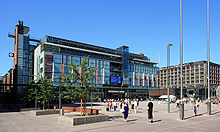 Kamppi Center, a shopping and transportation complex in the Kamppi district in the centre of Helsinki.
Kamppi Center, a shopping and transportation complex in the Kamppi district in the centre of Helsinki.
The Helsinki metropolitan area generates approximately one third of Finland's GDP. GDP per capita is roughly 1.3 times the national average.[35]
The metropolitan area's gross value added per capita is 200% of the mean of 27 European metropolitan areas, equalling those of Stockholm or Paris. The gross value added annual growth has been around 4%.[36]
83 of the 100 largest Finnish companies are headquartered in Greater Helsinki. Two-thirds of the 200 highest-paid Finnish executives live in Greater Helsinki and 42% in Helsinki. The average income of the top 50 earners was 1.65 million euro.[37]
The tap water is of excellent quality and it is supplied by 120 km (75 mi) long Päijänne Water Tunnel, one of the world's longest continuous rock tunnels. Bottled Helsinki tap water is even sold to countries such as Saudi Arabia.[38]
Education
Helsinki has 190 comprehensive schools, 41 upper secondary schools and 15 vocational institutes. Half of the 41 upper secondary schools are private or state-owned, the other half municipal. Higher level education is given in eight universities (see the section "Universities" below) and four polytechnics.
Universities
- University of Helsinki
- Aalto University (The Schools of Science are located in Espoo)
- Hanken School of Economics
- Academy of Fine Arts
- Sibelius Academy
- Theatre Academy
- National Defence University
Polytechnics
- Haaga-Helia University Of Applied Sciences
- Helsinki Metropolia University of Applied Sciences
- Arcada University of Applied Sciences
Helsinki is one of the co-location centres of the Knowledge and Innovation Community (Future information and communication society ) of The European Institute of Innovation and Technology (EIT).[39]
Culture
The biggest historical museum in Helsinki is the National Museum of Finland, which displays a vast historical collection from prehistoric times to the 21st century. The museum building itself, a national romantic style neomedieval castle, is a tourist attraction. Other major historical museum is the Helsinki City Museum, which introduces visitors to Helsinki's 500 year history. The University of Helsinki also has many significant museums, including the University Museum and the Natural History Museum.
The Finnish National Gallery consists of three museums: Ateneum Art Museum for classical Finnish art, Sinebrychoff Art Museum for classical European art, and Kiasma Art Museum for modern art. The old Ateneum, a neo-Renaissance palace from 19th century, is one of the city's major historical buildings. All three museum buildings are state-owned through Senate Properties.
Helsinki has three major theatres: The Finnish National Theatre, the Helsinki City Theatre, and the Finland Swedish Svenska Teatern. The city's main musical venues are the Finnish National Opera and the Finlandia concert-hall. Bigger concerts and events are usually held at one of the city's two big ice hockey arenas: the Hartwall Areena or the Helsinki Ice Hall. Helsinki has Finland's largest fairgrounds.
Many widely renowned and acclaimed bands have originated in Helsinki, including Hanoi Rocks, HIM, Stratovarius, The 69 Eyes, Norther, Wintersun, Finntroll, Ensiferum, The Rasmus and Apocalyptica.
Art
- The Helsinki Festival is an annual arts and culture festival, which takes place every August (including the Night of the Arts).
- Vappu "Vappu" is an annual carnival for students and workers.
Helsinki Arena hosted the Eurovision Song Contest 2007, the first ever Eurovision Song Contest arranged in Finland, following Lordi's win in 2006.
At the Senate Square in September / October 2010, the largest open-air art exhibition ever in Finland took place: About 1.4 million people saw the international exhibition of United Buddy Bears.
Helsinki is the 2012 World Design Capital, in recognition of the use of design as an effective tool for social, cultural and economic development in the city. In choosing Helsinki, the World Design Capital selection jury highlighted Helsinki's use of 'Embedded Design', which has tied design in the city to innovation, "creating global brands, such as Nokia, Kone and Marimekko, popular events, like the annual Helsinki Design Week, outstanding education and research institutions, such as the University of Art and Design Helsinki, and exemplary architects and designers such as Eliel Saarinen and Alvar Aalto".[10]
Media
National media
Helsinki is the centre of the Finnish media, most national newspapers as well as the broadcasters are located there.
Local media
There are two public service local radio stations in Greater Helsinki, Finnish-language Ylen aikainen (the regional edition of YLE Radio Suomi) and Swedish-language YLE Radio Vega Huvudstadsregionen (the regional edition of YLE Radio Vega). There are also privately-owned local radio stations.
YLE produces local TV news programme for the region of Uusimaa, Uudenmaan uutiset.
Two daily newspapers, Helsingin Sanomat and Hufvudstadsbladet are published in Helsinki and function as the local as well as the national newspapers.
Sports
Helsinki has a long tradition of sports: the city gained much of its initial international recognition during the 1952 Summer Olympics, and the city has since then been very open to arranging sporting events, for example the first World Championships in Athletics 1983 and 2005, and European Championships in Athletics 1971, 1994 and 2012 etc. Helsinki hosts fairly successful local teams in both of the most popular team sports in Finland, football, ice hockey and synchronized skating. Helsinki houses Helsingin Jalkapalloklubi (HJK), Finland's largest and most successful football club. Helsinki's track and field club Helsingin Kisa-Veikot is also pretty dominant in Finland. Ice Hockey is a sport of passion for many Helsinki residents, who usually take a stance for either of the local clubs IFK Helsingfors (HIFK) or Jokerit. HIFK, with 14 Finnish championships titles, also plays in the highest bandy division,[40] so does Botnia -69. The Olympic stadium hosted the 1st ever Bandy World Championships in 1957.[41]
Transportation
Roads
The backbone of Helsinki's motorway network consists of three semicircular ring roads, Ring I, Ring II, and Ring III, which connect together expressways heading to other parts of Finland, and the western and eastern arteries of Länsiväylä and Itäväylä respectively. While variants of a Keskustatunneli tunnel under the city centre have been repeatedly proposed, as of 2011 the plan remains on the drawing board.
Helsinki has some 390 cars per 1000 inhabitants.[42] This is less than in cities of similar density, for instance, Brussels' 483 per 1000 and Stockholm's 401, and Oslo's 413.[43][44]
Rail transport and buses
Public transportation is generally a hotly debated subject in the local politics of Helsinki. In Helsinki metropolitan area, public transportation is managed under Helsinki Region Transport, the metropolitan area transportation authority. The diverse public transport system consists of trams, commuter rail, the subway, bus lines and two ferry lines.
Today, Helsinki is the only city in Finland to have trams or subway trains. There used to be two other cities in Finland with trams: Turku and Viipuri (Vyborg, now in Russia), but both have since abandoned trams. The Helsinki Metro, opened in the year 1982, is the only subway system in Finland. In 2006, the construction of the long debated extension of the subway system west into Espoo was approved, and serious debate about an eastern extension into Sipoo has taken place.[45]
The possibility of a Helsinki to Tallinn Tunnel is currently being researched. The rail tunnel would connect Helsinki to the Estonian capital Tallinn, further linking Helsinki to the rest of continental Europe by Rail Baltica.
Aviation
Air traffic is handled primarily from the international Helsinki Airport, located approximately 19 kilometres (12 mi) north of Helsinki's downtown area, in the neighbouring city of Vantaa. Helsinki's second airport, Malmi Airport, is mainly used for general and private aviation. Copterline has provided fast (18 min.) helicopter flights to Tallinn, but discontinued the regular service in December 2008 on grounds of unprofitability.
Sea transport
Ferry connections to Tallinn, Mariehamn and Stockholm are serviced by various companies. Finnlines passenger-freight ferries to Gdynia, Poland, Travemünde, Germany and Rostock, Germany are also available. St Peter Line offers passenger ferry service to Saint Petersburg several times a week.
Gallery
-
Skyline of central Helsinki, as seen from the roof of the Erottaja fire station.
-
The Senaatintori square on a winter morning in December.
-
Stockmann department store along the Aleksanterinkatu's Christmas street.
-
Helsinki Olympic Stadium Tower, offers a good view over Helsinki.
-
The Esplanadi Park in central Helsinki in early june.
-
Finnish National Theatre and Aleksis Kivi statue in Rautatientori.
-
Altar of Temppeliaukio Church that is built underground
-
Hietaniemi beach in summer.
-
Itäkeskus is the biggest shopping mall in the Nordic countries.
References
- Notes
- ^ a b Ainiala, Terhi (2009). "Place Names in the Construction of Social Identities: The Uses of Names of Helsinki". Research Institute for the Languages of Finland. http://hdl.handle.net/10315/2924. Retrieved 22 September 2011.
- ^ "Area by municipality as of 1 January 2011" (in Finnish and Swedish) (PDF). Land Survey of Finland. http://www.maanmittauslaitos.fi/sites/default/files/pinta-alat_2011_kunnannimenmukaan.xls. Retrieved 9 March 2011.
- ^ a b "Population by municipality as of 31 January 2011" (in Finnish and Swedish). Population Information System. Population Register Center of Finland. http://vrk.fi/default.aspx?docid=4258&site=3&id=0. Retrieved 18 February 2011.
- ^ "Population according to language and the number of foreigners and land area km2 by area as of 31 December 2008". Statistics Finland's PX-Web databases. Statistics Finland. http://pxweb2.stat.fi/Dialog/varval.asp?ma=060_vaerak_tau_107_fi&ti=V%E4est%F6+kielen+mukaan+sek%E4+ulkomaan+kansalaisten+m%E4%E4r%E4+ja+maa%2Dpinta%2Dala+alueittain++1980+%2D+2008&path=../Database/StatFin/vrm/vaerak/&lang=3&multilang=fi. Retrieved 29 March 2009.
- ^ "Population according to age and gender by area as of 31 December 2008". Statistics Finland's PX-Web databases. Statistics Finland. http://pxweb2.stat.fi/Dialog/varval.asp?ma=050_vaerak_tau_104_fi&ti=V%E4est%F6+i%E4n+%281%2Dv%2E%29+ja+sukupuolen+mukaan+alueittain+1980+%2D+2008&path=../Database/StatFin/vrm/vaerak/&lang=3&multilang=fi. Retrieved 28 April 2009.
- ^ "List of municipal and parish tax rates in 2011". Tax Administration of Finland. 29 November 2010. http://www.vero.fi/nc/doc/download.asp?id=7996;193801. Retrieved 13 March 2011.
- ^ Helsinki region in brief
- ^ Vantaa city council agrees to a review of a possible merger proposal, HS.fi. Retrieved 30 March 2009.
- ^ Helsingin Sanomat, 1 February 2011, pp. A12-A13.
- ^ a b "City of Helsinki appointed World Design Capital 2012". Worlddesigncapital.com. 2009-11-25. http://www.worlddesigncapital.com/news/releases/main71.htm. Retrieved 2010-04-13.[dead link]
- ^ "Ruttopuisto – Plague Park". Tabblo.com. http://www.tabblo.com/studio/stories/view/409531/. Retrieved 2008-11-03.
- ^ "Utbildning & Vetenskap: Svenskfinland". Veta.yle.fi. http://veta.yle.fi/svenskfinland/artikel.php?id=23&subject=mellannyland. Retrieved 2009-07-08.
- ^ a b "Climatological statistics for the normal period 1971–2000". Fmi.fi. http://www.fmi.fi/weather/climate_6.html. Retrieved 2010-04-13.
- ^ Tukiainen, Matti. "Helsinki, Finland - Sunrise, sunset, dawn and dusk times around the World!". Gaisma. http://www.gaisma.com/en/location/helsinki.html. Retrieved 11 February 2011.
- ^ "Ilmatieteen laitos – Sää ja ilmasto – Ilmastotilastot – Ilman lämpötila" (in Finnish). Finnish Meteorological Institute. http://www.fmi.fi/saa/tilastot_4.html. Retrieved 2009-07-08.
- ^ "Stora Enson pääkonttori, Kanavaranta 1" (in Finnish). "Helsingin Aallot" blog. 25 February 2007. http://helsinginaallot.blogspot.com/2007/02/stora-enson-pkonttori-kanavaranta-1.html. Retrieved 5 February 2011.
- ^ "Kohtaako Enson konttori voittajansa?" (in Finnish). Helsingin Sanomat: Lead editorial. 14 June 2008. http://www.hs.fi/paakirjoitus/artikkeli/Kohtaako+Enson+konttori+voittajansa/HS20080614SI1MA01re3. Retrieved 5 February 2011.
- ^ Penttilä, Vappu. "Kiasma nousi inhokkien ykköseksi" (in Finnish). Verkkoliite. Helsingin Sanomat. http://www2.hs.fi/extrat/kulttuuri/rakennukset/rakennukset_c2.html. Retrieved 5 February 2011.
- ^ Ministry for Foreign Affairs of Finland, Political Department: Memo 56 of 20 January 1982 (labelled highly confidential in 1982)PDF (1.37 MB)
- ^ Tapani Valkonen ym. (2007-12-17). "Tutkimuksia 10/2007: Elinajanodotteen kehitys Helsingissä ja sen väestönosaryhmissä 1991–2005". http://www.hel2.fi/tietokeskus/julkaisut/pdf/07_12_17_tutk_10_Valkonen.pdf. Retrieved 2007-12-30.
- ^ Tilastolaitoksen historiaa. "Tilasto". Stat.fi. http://www.stat.fi/org/historia/elinajanodote.html. Retrieved 2010-04-13.
- ^ "Helsingin historia". Hel.fi. http://www.hel.fi/wps/portal/Helsinki/Artikkeli?WCM_GLOBAL_CONTEXT=/helsinki/fi/Helsinki-tietoa+ja+linkkej_/Helsingin+historia. Retrieved 2010-04-13.
- ^ "Maan alle". Aatos.fi. 1972-12-30. http://www.aatos.fi/Hki450v/metro.html. Retrieved 2010-04-13.
- ^ Butzin, Bernhard (1991). "Helsinki — aspects of urban development and planning". GeoJournal (Springer, Netherlands) 2 (1): 11–26. doi:10.1007/BF00212573. ISSN 0343-2521.
- ^ "HSL Helsingin seudun liikenne - About HSL". Hsl.fi. 2010-01-01. http://www.hsl.fi/EN/abouthsl/Pages/default.aspx. Retrieved 2010-04-13.
- ^ "HSY - Default". Hsy.fi. http://www.hsy.fi/en/Pages/default.aspx. Retrieved 2010-04-13.
- ^ "Taulukko: Väestö kielen mukaan sekä ulkomaan kansalaisten määrä ja maa-pinta-ala alueittain 1980 - 2008". Pxweb2.stat.fi. 2001-08-13. http://pxweb2.stat.fi/Dialog/Varvalagg.asp?ma=060%5Fvaerak%5Ftau%5F107%5Ffi&ti=V%E4est%F6+kielen+mukaan+sek%E4+ulkomaan+kansalaisten+m%E4%E4r%E4+ja+maa%2Dpinta%2Dala+alueittain++1980+%2D+2008&path=../Database/StatFin/vrm/vaerak/&lang=3&xu=&yp=&nr=1&aggfile%281%29=Maakunnat+ja+kunnat+2009&prevagg=NNN&mapname=&multilang=fi. Retrieved 2010-04-13.
- ^ "Immigrants Learning Swedish over Finnish Run into Problems | News | YLE Uutiset". yle.fi. http://yle.fi/uutiset/teksti/news/2010/11/immigrants_learning_swedish_over_finnish_run_into_problems_2114684.html. Retrieved 2011-09-16.
- ^ "Helsingin nimistön vaiheita". Scripta.kotus.fi. http://scripta.kotus.fi/www/verkkojulkaisut/julk125/helsinki/. Retrieved 2010-04-13.
- ^ IGS.kirjastot.fi
- ^ "Tilasto". Pxweb2.stat.fi. http://pxweb2.stat.fi/database/StatFin/vrm/vaerak/vaerak_fi.asp. Retrieved 2010-04-13.
- ^ Helsingin Sanomat (2008-12-07). "Helsingissä asuu virolaisia enemmän kuin venäläisiä". Hs.fi. http://www.hs.fi/kaupunki/artikkeli/Helsingiss%C3%A4+asuu+virolaisia+enemm%C3%A4n+kuin+ven%C3%A4l%C3%A4isi%C3%A4/1135241719777. Retrieved 2010-04-13.
- ^ Katriina Pajari (2008-12-07). "Kolmannes maahanmuuttajista asuu Helsingissä - HS.fi - Kaupunki". HS.fi. http://www.hs.fi/kaupunki/artikkeli/Kolmannes+maahanmuuttajista+asuu+Helsingiss%C3%A4/1135241719769. Retrieved 2010-04-13.
- ^ Elsa Tuppurainen (2008-12-03). "Jussi Pajunen jarruttaisi maahanmuuttoa". Hs.fi. http://www.hs.fi/kaupunki/artikkeli/Jussi+Pajunen+jarruttaisi+maahanmuuttoa/1135241571625. Retrieved 2010-04-13.
- ^ Helsinki Region Statistics Retrieved 2010-12-10.
- ^ "Kansilehti2.vp" (PDF). http://www.hel2.fi/Tietokeskus/julkaisut/pdf/04_11_09_suokas_vj31.pdf. Retrieved 2010-04-13.
- ^ "Helsingin Sanomat – International Edition – Metro". Hs.fi. 2005-11-09. http://www.hs.fi/english/article/Head+offices+of+large+companies+bring+good+taxpayers+to+Helsinki+region/1101981569833. Retrieved 2009-07-08.
- ^ Bottled water sells, Finnfacts
- ^ "European Institute of Innovation and Technology: Home". Eit.europa.eu. http://eit.europa.eu/home.html. Retrieved 2010-04-13.
- ^ Video from the Finnish final 2009 against OLS from Oulu: Youtube.com
- ^ Video from the tournament
- ^ This is Helsinki, by City of Helsinki
- ^ EAUE.de
- ^ "Tietokeskus: suunnatframe". Hel2.fi. http://www.hel2.fi/tietokeskus/suunnat/ss405/suunnatframe2.html. Retrieved 2009-07-08.
- ^ Lansimetro.fi – an information portal dedicated to the "länsimetro" subway expansion in the Helsinki capital region.
External links
- Helsinki travel guide from Wikitravel
- Scenaries, sights, and places to go in and near Helsinki in Wikimedia Commons
- Hel.fi – Official website (in English; other languages available)
- Visithelsinki.fi – Official City of Helsinki Tourism Website
- Helsinki.mobi – Official mobile website
- Helsinki.fi – City Portal
- World Design Capital 2012 Helsinki Official site
Preceded by
Athens, Greece 2006Eurovision Song Contest Hosts Helsinki
2007Succeeded by
Belgrade, Serbia 2008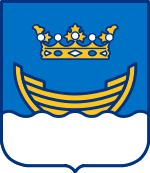
Places of worship: Monuments & memorials: Parks & gardens: Tourist attractions: Museums: Municipalities of Uusimaa Municipalities Askola · Espoo · Hanko · Helsinki · Hyvinkää · Ingå · Järvenpää · Karjalohja · Karkkila · Kauniainen · Kerava · Kirkkonummi · Lapinjärvi · Lohja · Loviisa · Mäntsälä · Myrskylä · Nummi-Pusula · Nurmijärvi · Pornainen · Porvoo · Pukkila · Raseborg · Sipoo · Siuntio · Tuusula · Vantaa · Vihti
Former municipalities Uusimaa · Finland Capitals of European states and territories Capitals of non-sovereign territories or constituent nations shown in SmallCaps Western Northern Central Southern Eastern Amsterdam, 6 Netherlands
Andorra la Vella, Andorra
Belfast, Northern Ireland
Brussels, 5 Belgium
Douglas, Isle of Man 4
Cardiff, Wales
Dublin, Ireland
Edinburgh, Scotland
Lisbon, Portugal
London, United Kingdom, England
Luxembourg, Luxembourg
Madrid, Spain
Monaco, Monaco
Paris, France
Saint Helier, Jersey 4
Saint Peter Port, Guernsey 4Ankara, Turkey 1
Athens, Greece
Gibraltar, Gibraltar 4
Nicosia, Cyprus 2
North Nicosia, Northern Cyprus 2, 3
Podgorica, Montenegro
Pristina, Kosovo 3
Rome, Italy
San Marino, San Marino
Sarajevo, Bosnia and Herzegovina
Skopje, Republic of Macedonia
Sofia, Bulgaria
Tirana, Albania
Valletta, Malta
Vatican City, Vatican CityAstana, Kazakhstan 1
Baku, Azerbaijan 1
Bucharest, Romania
Chişinău, Moldova
Kiev, Ukraine
Minsk, Belarus
Moscow, Russia 1
Stepanakert, Nagorno-Karabakh 2, 3
Sukhumi, Abkhazia 2, 3
Tbilisi, Georgia 1
Tiraspol, Transnistria 3
Tskhinvali, South Ossetia 2, 3
Yerevan, Armenia 11 Transcontinental country. 2 Entirely in Southwest Asia but having socio-political connections with Europe. 3 Partially recognised country. 4 Crown Dependency or Overseas Territory of the United Kingdom. 5 Also the seat of the European Union, see Location of European Union institutions and Brussels and the European Union. 6 Also the capital of the Kingdom of the Netherlands. 7 Also the capital of the Kingdom of Denmark. Capital cities of the Member States of the European Union 
50 most populous urban areas in the Nordic countries  Denmark ·
Denmark ·  Finland ·
Finland ·  Iceland ·
Iceland ·  Norway ·
Norway ·  Sweden
Sweden1.  Stockholm
Stockholm1,372,565 2.  Copenhagen
Copenhagen1,199,224 3.  Helsinki
Helsinki1,029,773 4.  Oslo
Oslo907,288 5.  Gothenburg
Gothenburg549,839 6.  Malmö
Malmö280,415 7.  Aarhus
Aarhus249,709 8.  Turku
Turku236,226 9.  Bergen
Bergen234,800 10.  Stavanger
Stavanger221,616 21.  Örebro
Örebro107,038 22.  Linköping
Linköping104,232 23.  Lahti
Lahti100,444 24.  Drammen
Drammen100,023 25.  Helsingborg
Helsingborg97,122 26.  Kuopio
Kuopio91,845 27.  Jönköping
Jönköping89,396 28.  Kouvola
Kouvola88,396 29.  Norrköping
Norrköping87,247 30.  Skien
Skien86,923 31.  Lund
Lund82,800 32.  Umeå
Umeå79,594 33.  Pori
Pori76,562 34.  Joensuu
Joensuu72,167 35.  Esbjerg
Esbjerg71,576 36.  Gävle
Gävle71,033 37.  Lappeenranta
Lappeenranta70,210 38.  Kristiansand
Kristiansand67,547 39.  Tromsø
Tromsø66,669 40.  Borås
Borås66,273 41.  Hämeenlinna
Hämeenlinna66,257 42.  Eskilstuna
Eskilstuna64,679 43.  Södertälje
Södertälje64,619 44.  Karlstad
Karlstad61,685 45.  Täby
Täby61,272 46.  Randers
Randers60,656 47.  Rovaniemi
Rovaniemi59,274 48.  Vaasa
Vaasa58,607 49.  Halmstad
Halmstad58,577 50.  Kolding
Kolding57,197 European Capitals of Culture 1985 Athens · 1986 Florence · 1987 Amsterdam · 1988 West Berlin · 1989 Paris · 1990 Glasgow · 1991 Dublin · 1992 Madrid · 1993 Antwerp · 1994 Lisbon · 1995 Luxembourg City · 1996 Copenhagen · 1997 Thessaloniki · London 1998 Stockholm · 1999 Weimar · 2000 Reykjavík · Bergen · Helsinki · Brussels · Prague · Kraków · Santiago de Compostela · Avignon · Bologna · 2001 Rotterdam · Porto · 2002 Bruges · Salamanca · 2003 Graz · 2004 Genoa · Lille · 2005 Cork · 2006 Patras · 2007 Luxembourg City and Greater Region · Sibiu · 2008 Liverpool · Stavanger · 2009 Linz · Vilnius · 2010 Essen · Istanbul · Pécs · 2011 Turku · Tallinn · 2012 Maribor · Guimarães · 2013 Košice · Marseille · 2014 Umeå · Riga · 2015 Mons · Plzeň · 2016 San Sebastián · Wrocław
Summer Olympic Games host cities 1896:
 Athens • 1900:
Athens • 1900:  Paris • 1904:
Paris • 1904:  St. Louis • 1908:
St. Louis • 1908:  London • 1912:
London • 1912:  Stockholm • 1920:
Stockholm • 1920:  Antwerp • 1924:
Antwerp • 1924:  Paris • 1928:
Paris • 1928:  Amsterdam • 1932:
Amsterdam • 1932:  Los Angeles • 1936:
Los Angeles • 1936:  Berlin • 1940: cancelled • 1944: cancelled • 1948:
Berlin • 1940: cancelled • 1944: cancelled • 1948:  London • 1952:
London • 1952:  Helsinki • 1956:
Helsinki • 1956:  Melbourne • 1960:
Melbourne • 1960:  Rome • 1964:
Rome • 1964:  Tokyo • 1968:
Tokyo • 1968:  Mexico City • 1972:
Mexico City • 1972:  Munich • 1976:
Munich • 1976:  Montreal • 1980:
Montreal • 1980:  Moscow • 1984:
Moscow • 1984:  Los Angeles • 1988:
Los Angeles • 1988:  Seoul • 1992:
Seoul • 1992:  Barcelona • 1996:
Barcelona • 1996:  Atlanta • 2000:
Atlanta • 2000:  Sydney • 2004:
Sydney • 2004:  Athens • 2008:
Athens • 2008:  Beijing • 2012:
Beijing • 2012:  London • 2016:
London • 2016:  Rio de Janeiro
Rio de Janeiro1983: Helsinki -
 Finland • 1987: Romes -
Finland • 1987: Romes - Italy • 1991: Tokyo -
Italy • 1991: Tokyo - Japan • 1993: Stuttgart -
Japan • 1993: Stuttgart - Germany • 1995: Gothenburg -
Germany • 1995: Gothenburg - Sweden • 1997: Athens -
Sweden • 1997: Athens - Greece • 1999: Seville -
Greece • 1999: Seville - Spain • 2001: Edmonton -
Spain • 2001: Edmonton - Canada • 2003: Saint-Denis -
Canada • 2003: Saint-Denis - France • 2005: Helsinki -
France • 2005: Helsinki -  Finland • 2007: Osaka -
Finland • 2007: Osaka - Japan • 2009: Berlin -
Japan • 2009: Berlin - Germany • 2011: Daegu -
Germany • 2011: Daegu - South Korea • 2013: Moscow -
South Korea • 2013: Moscow - Russia •
Russia •Host cities of the Eurovision Song Contest 1950s 1960s 1970s 1980s The Hague · Dublin · Harrogate · Munich · Luxembourg · Gothenburg · Bergen · Brussels · Dublin · Lausanne1990s 2000s 2010s Categories:- Host cities of the Summer Olympic Games
- Capitals in Europe
- Cities and towns in Finland
- Populated coastal places in Finland
- European Capitals of Culture
- Helsinki
- Municipalities of Uusimaa Region
- Port cities and towns in Finland
- Port cities and towns of the Baltic Sea
- Populated places established in 1550
Wikimedia Foundation. 2010.

